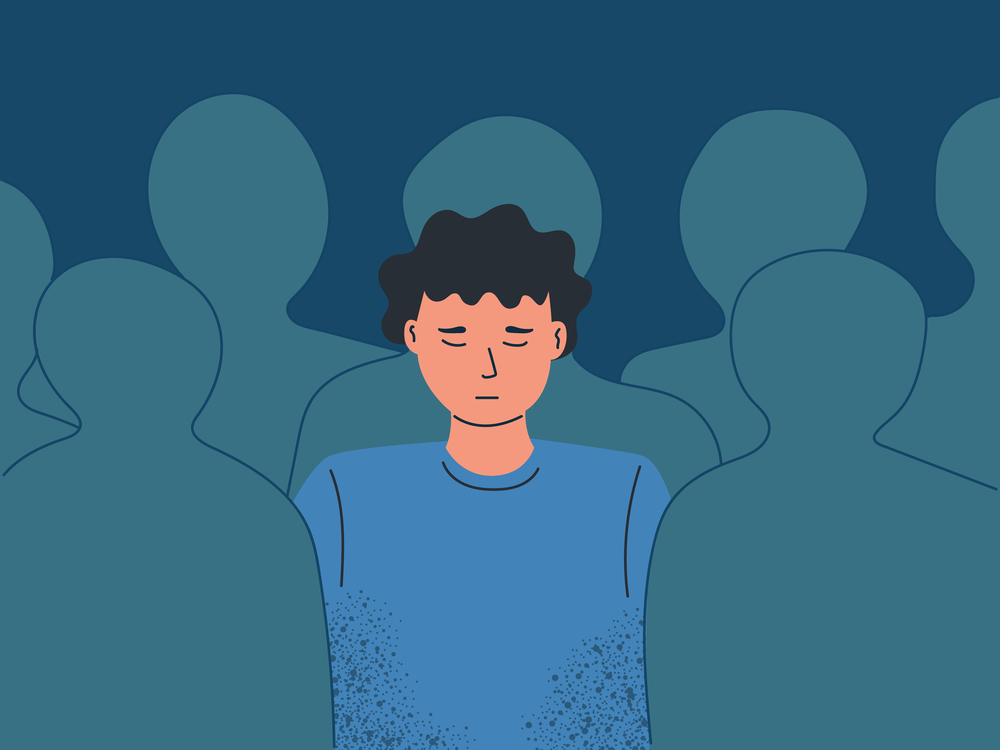Between 1987 and 2007, the number of people receiving treatment for depression in the United States increased fourfold (and has continued to rise more gradually since). However, the prevalence of depression either stayed the same—or may have even increased—during that time. Researchers call this the “treatment-prevalence paradox” (TPP).
Now, in a new study, researchers review the seven possible explanations for this—and the evidence for and against each one. The study was led by Johan Ormel at the University of Groningen, The Netherlands, and published in Clinical Psychology Review.
Ormel and his co-authors explain:
“The increased availability of effective treatments should shorten depressive episodes, reduce relapses, and curtail recurrences. Combined, these treatment advances unequivocally should result in lower point-prevalence estimates of depression. Have these reductions occurred? The empirical answer clearly is NO.”
 If depression functioned like other treatable medical conditions, the overall percentage of people experiencing any incidence of depression in their lifetime (lifetime prevalence) would remain stable. However, the point-prevalence (how many people experience it at any given time) would be decreased when more people receive successful treatment.
If depression functioned like other treatable medical conditions, the overall percentage of people experiencing any incidence of depression in their lifetime (lifetime prevalence) would remain stable. However, the point-prevalence (how many people experience it at any given time) would be decreased when more people receive successful treatment.
That is, the same number of people would likely present initially with depression. But if the treatment worked, and was delivered to many of those people, then a follow-up study would find a lower prevalence of depression.
Yet, according to the researchers, we have found just the opposite. They write:
“Major repeated cross-sectional studies also fail to find any decrease in the prevalence of depression. The US-based National Comorbidity Study (NCS, N ~ 5000) and the Dutch-based NEMESIS study (N ~ 7000), which both examined trends over periods of 10–12 years around 2000, each failed to find significant change in 12-month prevalence of MDD. However, more recently, two large repeated cross-sectional studies reported a small, but statistically significant, increase. We conclude that a prevalence decrease is highly unlikely, but that a small increase since the turn of the century remains possible, especially in adolescents.”
The researchers propose seven possible explanations, grouped into two categories:
Two explanations involve treatment being effective but offset by either diagnostic expansion in prevalence studies or a large actual increase in first episodes of depression. However, the researchers write that the evidence does not support these explanations.
Instead, they point to the other five explanations—that depression treatment is nowhere near as effective as claimed (for various reasons)—as more likely to result in this phenomenon.
The Explanations, in Detail
1.) The first explanation is that prevalence studies detect more depression, but that treatment also reduces depression prevalence—resulting in the total prevalence remaining the same. This relies on the notion that people are now more apt to report depressive symptoms (because of reduced stigma) and/or that experiences once considered normal sadness are being misdiagnosed in prevalence studies as “depression.”
The researchers write that these are valid possible explanations in real-life practice. However, prevalence studies employ diagnostic interviews conducted by experts, and it is unlikely that these shifts have affected that particular format.
They write, “Overall, it is doubtful that significant drift in case-definition and -ascertainment has occurred in epidemiological studies employing structured interviews, standardized classification, and well-trained interviewers.”
Looking at the available evidence, they suggest that it is unlikely that treatment has decreased true prevalence (only to be masked by expanding diagnosis and reduced stigma). Instead, they conclude that prevalence is increased, especially for youth:
“Neither greater willingness to disclose symptoms nor greater medicalization of distress over the last few decades is likely to have masked any significant underlying treatment-driven decrease in MDD prevalence. Explanation 1 can be ruled out as a strong explanation for the TPP.”
2.) The second explanation is that prevalence has increased because many more people are experiencing a first episode of depression than in the past. For this reason, even if many are receiving effective treatment, there are still more people with depression at any given time.
The researchers reviewed epidemiological studies to determine whether more people are experiencing a first episode of depression. They found that this is unlikely—the biggest and most accurate studies (ECA and NESARC in the US, and NEMESIS-2 in the Netherlands) found that first episode prevalence has remained stable since the 1980s—or may have even decreased slightly.
“Overall, the evidence does not support any major rise in incidence. Explanation 2 also can be ruled out as a strong explanation for the TPP,” they write.
If fewer people are experiencing a first episode of depression, but prevalence rates are increasing, that implies that depression treatment may not only be ineffective but actually harmful.
3.) The third explanation is that the efficacy of acute-phase treatment is smaller than we think. That is, although clinical trials find a statistically significant improvement in depression over the short term, this effect could be biased in several ways—which means the treatment doesn’t show the same results in the real world.
According to the researchers, this is true for both antidepressant drugs and psychotherapy. They conclude that these treatments show benefit over placebo in the short-term, but this benefit is much smaller than early studies claimed.
This is consistent with recent reviews, which suggest that the statistically significant effect of treatments is clinically insignificant when compared to placebo—so small that neither the patient nor the doctor can tell the difference. Another study indicates that there may be a small group of people—around 15%—who receive a clinically significant effect from antidepressant drugs. However, researchers have also suggested that this effect could be due to bias in clinical trials, such as unblinding.
4.) The fourth explanation is that treatments for depression may work to some degree in the short term, but they don’t prevent relapse or recurrence. People are still likely to have recurring episodes of depression, so while the duration of an episode may be decreased by treatment, the number of episodes of depression a person experiences still remains high.
In fact, studies have found that the risk of relapse is three times higher for people who take antidepressants. That is, antidepressant drugs may be causing a more chronic, relapsing form of depression. (See explanation 7.)
5.) The fifth explanation is that clinical trials of depression treatment don’t generalize to the real world. Clinical trials are set up to maximize the likelihood of finding a positive effect and exclude most people who receive treatment in real life. In real life, patients usually have multiple diagnoses, substance abuse, and may experience suicidal thoughts—all factors that are typically exclusion criteria for participating in clinical trials.
Another difference: The researchers write that medication regimens are not followed as clearly in real life; many people stop taking the drug or don’t take it consistently, and prescribers don’t follow up sufficiently. Likewise, psychotherapy is delivered in a more vague, scattershot approach—an “integrative” style—rather than following the treatment manuals that have actually been tested in clinical trials.
One study in real-world patients found that antidepressants were no better than placebo—even for severe depression. Another study found that in the real world, less than 25% of people respond to aggressive depression treatment, including treatment with multiple drugs, add-on psychotherapy, and even hospitalization.
These findings are startling because studies looking at the naturalistic course of depression—how many people recover without treatment—have found high recovery rates in those who did not receive treatment. For instance, in one 2006 study, more than 52% recovered within three months, and 85% recovered within one year without taking antidepressants.
“Once transported into the real world, characterized by tougher patients and less adequate implementation, the already modest treatment effects for both medication and psychotherapy diminish even further. Explanation 5 remains a strong candidate for helping to understand the TPP, in particular in combination with explanations 3 and 4.”
6.) The sixth explanation builds on the findings of the naturalistic course of depression: if most people don’t experience recurrent depression, and recover on their own without seeking treatment, then any treatment effects that do exist won’t make much of an impact—their efficacy will be drowned out by the majority of people who are simply getting better without treatment.
They write that if this is the case, studies should show that treatment has more of an impact on those who have longer episodes of depression and who have recurring depression. Yet, they write, studies do not clearly show this. They propose that this explanation is still a strong contender, but there is limited evidence to actually support it.
“The impact of more and better treatments should be more readily apparent for the smaller subset of cases who are at risk for having longer episodes and many recurrences or chronicity. Yet it remains unclear to what degree treatment advances affect the lifetime course for these chronic-recurrent subset, if these treatments are provided to them in routine clinical care, and whether or not their impact can eventually reveal a more robust treatment-induced prevalence drop,” they write.
7.) The final explanation is that antidepressant drugs (or treatment in general) may be responsible for more harm than benefit. Thus, even if a small number of people experience a short-term benefit, this may be offset by long-term failure and an increased number of relapses.
The researchers suggest that being diagnosed and receiving drugs reduces people’s sense of agency—their belief that they can change their lives. In essence, this means that receiving treatment for depression leads to a depressive mindset—that these negative feelings are permanent and unchangeable. In addition, receiving a diagnosis and drugs convinces people that they have a neurobiological problem that is treated medically—so they don’t pursue activities that have been found to alleviate depression, such as exercising, increasing pleasant activities, reducing stressful situations, and meditating.
To this effect: Studies have found that exercise alone is just as good as antidepressants for mild to moderate depression, with fewer potential harms. Other analyses have found that exercise has a preventative effect. So if diagnosis and treatment make people believe that drugs are the answer to a “chemical imbalance,” they may not be motivated to try these alternatives, like exercise, despite the strong evidence for their success.
The researchers also suggest iatrogenic harm from drug-mediated effects. For instance, as SSRIs perturb neurobiology, the brain adapts to create homeostasis. This can lead to multiple effects, such as tolerance—in which the drug becomes ineffective over time—and tardive dysphoria, in which the brain’s adaptation to long-term antidepressant use creates a state of chronic, relapsing depression—about which researchers have warned since the 1990s.
Indeed, researchers have repeatedly found that in the long term, those who take antidepressants end up feeling worse than those who don’t—even after controlling for baseline severity and other factors. In addition, researchers argue that the use of antidepressants leads to a more chronic, recurring depression, while those who recover without using the drugs tend to return to normal functioning.
In the current paper, the researchers write that only indirect evidence is available to support this notion, despite the sources cited above.
Conclusions
So which explanations do the researchers consider most likely to explain why, as treatment supposedly improves and is delivered to a larger and larger percentage of the population, the prevalence of depression remains the same?
Ormel and the other researchers conclude that there is no evidence to support the notion that depression prevalence is actually increasing (to offset a beneficial treatment effect). Instead, the most likely reasons for the treatment-prevalence paradox are that the treatments are much less effective than we have been led to believe. The clinical trial results are overly optimistic due to the focus on statistical significance and forms of bias, as well as the fact that they don’t include the types of patients actually seen in real life.
“Compared to its absence, as indexed by spontaneous remission and natural history, the absolute long-term effectiveness of treatment in real-world settings is disappointingly modest. The overestimated efficacy in controlled trials is largely attributable to a variety of biases (Explanations 3 and 4), and the modest RCT-based efficacy is strongly amplified by substantial gaps in the quality of implementation in real-world settings (Explanation 5). Collectively, these three explanations likely go a long way to help explain the TPP.”
Finally, they write that more research should be devoted to the iatrogenic harms of antidepressants, including the idea that the drugs themselves can cause the chronic, recurring form of depression known as tardive dysphoria.
They add that those at the highest risk of recurrent or chronic depression should receive psychotherapy, primarily if it can be delivered in a way that more closely adheres to the way experts deliver it in clinical trials rather than the vague, integrative approach commonly seen in real life.
****
Ormel, J., Hollon, S. D., Kessler, R. C., Cuijpers, P., & Monroe, S. M. (2022). More treatment but no less depression: The treatment-prevalence paradox. Clinical Psychology Review, 91, 102111. https://doi.org/10.1016/j.cpr.2021.102111 (Link)















None of these professionals, though far more formally educated than I am, seem to realize that depression is a syndrome, not a disease unto itself, which means that no single treatment will be effective for all patients, many not needing and/or not responsive to antidepressants and possibly made worse by them.
Report comment
I think the whole point of making depression a person’s issue rather than a society’s failure may be the culprit but that may scare people and make people feel so powerless so just beat down the dead horse of an individual living in sick society!
The question is not about “effective” treatment but what is in the environment supporting this in the individual?
Report comment
You are 100% correct. The first part of de-pathologizing depression is recognizing that it is your environment that is causing the issues which can indeed create feelings of powerlessness. Mental health workers need to work on finding ways to create community instead of just treating people individually. Without community support that creates solidarity and promotes action against the toxic environment causing the problems, it can definitely feel hopeless. I really, really hope things are moving in that direction. I’m seeing more of it but definitely not enough.
Report comment
How about ADDING a NUMBER 8) explanation to the number 7) (which seems to make the most scientific sense).
How can this entire article be written WITHOUT making reference to the kind of world human beings are currently living in???
“7) The final explanation is that antidepressant drugs (or treatment in general) may be responsible for more harm than benefit. Thus, even if a small number of people experience a short-term benefit, this may be offset by long-term failure and an increased number of relapses.”
AND FINALLY…
8) Human beings live in a very stressful and traumatic world filled with economic, political, and social inequality, with ongoing daily stressors that continuously push people over the edge of psychological tolerance. NO AMOUNT of so-called “treatment” or other social support systems can overcome this environmental disadvantage. Make the world a more hospitable and compassionate place to live, AND THEN the depression rates will start to decline dramatically.
Richard
Report comment
Well said, ESPECIALLY #8!
Report comment
It’s only a “paradox” if one insists that “treatment” MUST a priori be effective. If one instead simply asks the question, “Does ‘treatment’ improve the ‘symptoms’ of ‘major depressive disorder’ over time?” there is no paradox. The answer is quite simply, “NO!”
Report comment
Remember, Steve, that “major depressive disorder” is just a description, not a disease unto itself. There can be any number of entities inducing this syndrome and many will have treatments that will leave shrinks scratching their heads, because they don’t grasp that a variety of conditions with a variety of treatments are effective for the entities that are described as ”major depressive disorders”.
Report comment
The fundamental error of the whole “DSM” model is the assumption that you can group people together based on how they feel, think or behave and that somehow all those people not only have something “wrong” with them but that they all have the SAME THING “wrong” with them. It is an absurd proposition, but I don’t think it’s by chance that they came up with it. It’s a great strategy for selling drugs!
Report comment
Yes its not science, its pseudoscience. 70 years ago Wittgenstein wrote that the barrenness of psychology is not to be explained by suggesting it is a young science (like physics was when it started), but due to basic conceptual confusions. It uses the empirical method, but the method is useless whilst these conceptual confusions remain. Before embarking on a scientific endeavour you have to sort out your concepts – the confusions in philosophy disappear when everyone agrees – they literally dissolve. We say, “now I can go on”.
Report comment
So very true! A lack of philosophical clarity about meanings and values and intent and language dooms any “scientific” effort to failure. In this case, the most basic tenets of science are violated from day one: You can’t do a scientific experiment by assuming a heterogeneous group has something in common with each other. Lacking a clear distinction of an “in” and an “out” classification, no further experiment can be done. Of course, there are tons of other problems with psychiatry, such as whom is it intended to serve, what the purpose of the enterprise is, who gets to decide what “works” means, and on and on. It astounds me that any thinking person can take psychiatry’s pretense seriously!
Report comment
The fundamental error of the DSM is that it was created as a way to submit insurance claims for reimbursements.
I think that there can actually be some power in grouping people together that have the same things “wrong” with them because solidarity and connection is important, especially when isolation in the feeling of powerlessness is a primary contributor to depression. From a liberation psychology standpoint, solidarity is a major part of de-pathologizing symptoms that are completely valid and not in any way biological, and then working together to push back against the societal and systemic reasons that they are experiencing. What we’re missing is collective action. How amazing would it be of mental health professionals started organizing people for the purposes of self-liberation? It would be powerful to those suffering.
Report comment
You are right, it is essential to find solidarity with people with similar realities! But that is VERY different than someone else deciding FOR you what group you belong with on some arbitrary criteria, and particularly telling us what we have to DO about our supposed “condition!” We should be the ones deciding for ourselves what group we belong to and who are our “people” and what it means to be part of that community!
I’m sure I’m preaching to the choir, but I just wanted to emphasize that point!
Report comment
Depression is not a problem to be solved. Psyche is not empiricism.
Report comment
Depression is a normal reaction to things going on around us. Let’s talk and learn compassion and understanding. Can we put words to the feeling? Who might help us unravel the story of our past experience?
Report comment
Why is there a “treatment-prevalence paradox”?
Because there’s so many stupid “researchers” who think up stupid terms like “TPP” in the first place — yet STILL recommend something as stupid as “psychotherapy”.
They obviously haven’t heard the phrase, “stupid is as stupid does”, or, to use a more “scientifically” acceptable term, “reflective functioning”.
Sure depresses the hell outta me –
Report comment
TPP “researchers” still recommend “psychotherapy”. How’s THAT for paradox?
Report comment